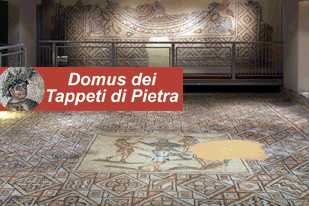On the traces of Giotto(alias Pietro da Rimini) in Ravenna


On the traces of Giotto(alias Pietro da Rimini) and other anonymous XIV century Maestri. Hotels in the historic centre of Ravenna.
Photo:1)Pieve S. Pietro in Silvis, Bagnacavallo (Ra),2)a fresco
The idea of Dante and Giotto talking in Ravenna about their art is surely fantastic and almost incredible.
The fact remains, however, that the "new Italian painting" of the main churches in Ravenna have been attributed to Giotto, who was always at work between 1317 and 1321, Dante Alighieri's date of death, for many centuries.
Today, all these paintings have disappeared, or are preserved elsewhere, or are hidden, as minuscule jewels, in the inside of decorative apparatus that become more and more rich and sumptuousness over the centuries.
What we are proposing, in other words, is a kind of treasure hunt on the traces of a genial and original painter named Pietro, not Giotto, from Rimini (but painting lovers know that Rimini is not so far from Assisi or Padova)
Pietro da Rimini headed a school of local Rimini painters during the Polentani lordship in Ravenna in the first half of XIV century.
Pietro's style is easily recognizable from the high proportioned, small headed figures in rigid postures ( close to the Bizantine exemples in Ravenna) , plentiful and rhythmical draperies.
Pietro's mellow frescos, with genial architectural aspects, that he depicted in the vault of Santa Chiara are still complete and visible today at the National Museum, as well as those with very tender colours in Pieve di Bagnacavallo, (not so far from here) and the charming story in the refectory of Pomposa.
Fans of Pietro's works, could not forget to look at the photos, in the Classense Library, of a sumptuous fresco cycle, once in the church of Santa Maria in Porto Fuori, destroyed during the last air raid on Ravenna at the end of the Second World War.
In almost every church, you will recognize the small jewels by Maestri of XIV century - superiors of religious orders used to call in to Ravenna from time to time to enjoy their simplicity, grace and delicacy.
They are in the Dome, in Santa Apollinare Nuovo, in San Nicolò, in San Giovanni Battista, in San Domenico (in the sacristy and in the chapel in the bell tower), in san Giovanni Evangelista, in Sant'Agata (two delicious faces of Angels smiling at the wall, even if dominated by a big canvas by Luca Longhi) in San Francesco. The romagnolo and bolognese XIV century is all in here, after all.
Prof. Gianni Morelli
The pleasure of fine accommodation in the centre of Ravenna: we recommend the Fabbri hotels for a pleasant stay as follows:
The Centrale Byron Hotel, 3-star hotel in the centre of Ravenna, close to the main momuments;
The Bisanzio Hotel, 4-star hotel in the centre of Ravenna, close to the main momuments;
Once you have reached the hotel and parked your car, forget it and walk everywhere, because everything is within walking distance.
The railway station is near our hotels and within walking distance





